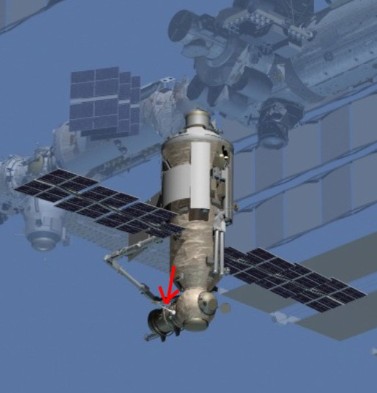la Russie ajoutera 3 modules à son segment avant 2011
Page 5 sur 5
Page 5 sur 5 •  1, 2, 3, 4, 5
1, 2, 3, 4, 5
A quoi sert l'élément qu'ils installent sur le MRM-1 ? Sur la config de l'ISS, il ne semble pas être sur le MRM-1 mais sur le MLM qui sera lancé plus tard. Il me semblait avoir lu l'explication ici mais je ne retrouve pas le message.
http://www.roscosmos.ru/NewsDoSele.asp?NEWSID=7708


http://www.roscosmos.ru/NewsDoSele.asp?NEWSID=7708

Invité- Invité
A mon avis ça ressemble à ce qui peut être un sas qui sera sur MLM ou cet élément a-t-il une autre fonction :???:



urix- Messages : 588
Inscrit le : 28/02/2008
Age : 34
Localisation :
Ce doit ça que tu cherches Steph ?, c'est en page 5 de ce post :
"Mini Research Module – 1- Docking and Cargo Module, MRM-1 - DCM (Maliy issledovatelskiy modul-1 – stykovochno-gruzovoi modul, МИМ1-СГМ) will be used to ensure operations of Soyuz and Progress, as well as to deliver various cargo to ISS. This module is constructed under contract with NASA, its full description is in Novosti Kosmonavtiki, issue # 6 for 2007, pages 20-21.
Main technical specifications of the module: mass at start – 7900 kg, diameter – 2.4 m, length – 6.55 m, pressurized volume – 18 m3, pressurized storage volume inside the module - 5 m3, one workplace for the scientific equipment on an external surface of the module. The following cargo would be delivered at the exterior of the module: MLM airlock, MLM radiator, spare elbow joint for European Manipulator Arm (ERA) and transferable workplace with ERA mounting platform. All those elements would be transferred to MLM in the future.
MRM-1 – DCM launch is planned for March 2010 at STS-132/ISS-ULF4. Module would be installed at the nadir port of FGB “Zarya”.
"Mini Research Module – 1- Docking and Cargo Module, MRM-1 - DCM (Maliy issledovatelskiy modul-1 – stykovochno-gruzovoi modul, МИМ1-СГМ) will be used to ensure operations of Soyuz and Progress, as well as to deliver various cargo to ISS. This module is constructed under contract with NASA, its full description is in Novosti Kosmonavtiki, issue # 6 for 2007, pages 20-21.
Main technical specifications of the module: mass at start – 7900 kg, diameter – 2.4 m, length – 6.55 m, pressurized volume – 18 m3, pressurized storage volume inside the module - 5 m3, one workplace for the scientific equipment on an external surface of the module. The following cargo would be delivered at the exterior of the module: MLM airlock, MLM radiator, spare elbow joint for European Manipulator Arm (ERA) and transferable workplace with ERA mounting platform. All those elements would be transferred to MLM in the future.
MRM-1 – DCM launch is planned for March 2010 at STS-132/ISS-ULF4. Module would be installed at the nadir port of FGB “Zarya”.
Merci, ça répond à ma question, il s'agit bien du sas du MLM.

Invité- Invité
ISS: le plus grand module spatial russe lancé en 2012 (Roskosmos)
Le plus grand module spatial russe MLM fera partie de la Station spatiale internationale (ISS) en 2012 au plus tard, a annoncé jeudi à Moscou le directeur de l'Agence fédérale spatiale russe (Roskosmos) Anatoli Perminov.
"Nous préparons un module de recherche qui sera lancé à la fin de 2011 ou en 2012. Ce sera le plus grand module russe conçu par la société de construction spatiale russe RKK Energuia et le Centre de production et de recherche spatiale Khrounitchev.
Le laboratoire polyvalent russe MLM remplacera le module Pirs arrimé au module russe Zvezda. Pirs se séparera de l'ISS en novembre 2011 et sera immergé dans l'océan par un cargo Progress. Les équipements qui permettront au laboratoire MLM d'effectuer un vol autonome et ensuite de s'amarrer à l'ISS seront évacués par un autre Progress.
L'ISS compte actuellement quatre modules russes - Zvezda, Zaria, Pirs et Poisk - et sera dotée d'un cinquième - le laboratoire Rassvet (Aube), anciennement connu sous le nom de MIM-1 (Petit Module de Recherche-1) - en mai 2010.
Le plus grand module spatial russe MLM fera partie de la Station spatiale internationale (ISS) en 2012 au plus tard, a annoncé jeudi à Moscou le directeur de l'Agence fédérale spatiale russe (Roskosmos) Anatoli Perminov.
"Nous préparons un module de recherche qui sera lancé à la fin de 2011 ou en 2012. Ce sera le plus grand module russe conçu par la société de construction spatiale russe RKK Energuia et le Centre de production et de recherche spatiale Khrounitchev.
Le laboratoire polyvalent russe MLM remplacera le module Pirs arrimé au module russe Zvezda. Pirs se séparera de l'ISS en novembre 2011 et sera immergé dans l'océan par un cargo Progress. Les équipements qui permettront au laboratoire MLM d'effectuer un vol autonome et ensuite de s'amarrer à l'ISS seront évacués par un autre Progress.
L'ISS compte actuellement quatre modules russes - Zvezda, Zaria, Pirs et Poisk - et sera dotée d'un cinquième - le laboratoire Rassvet (Aube), anciennement connu sous le nom de MIM-1 (Petit Module de Recherche-1) - en mai 2010.

Doc- Messages : 1591
Inscrit le : 14/03/2010
Age : 38
Localisation : Basse-normandie
Le MLM est traité sur http://www.forum-conquete-spatiale.fr/iss-f30/les-nouvelles-du-module-mrm1-rassvet-de-l-iss-t9523.htm
Sujet retrouvé par la méthode donnée par Steph :
module spatial russe MLM +site:www.forum-conquete-spatiale.fr
Sujet retrouvé par la méthode donnée par Steph :
module spatial russe MLM +site:www.forum-conquete-spatiale.fr

Fan de Ducrocq- Messages : 3282
Inscrit le : 11/12/2009
Age : 73
Localisation : Lorient - Morbihan - Bretagne - France - Europe
Lors de sa conférence de presse à Baïkonour Perminov a donné des indications intéressantes sur les futurs vols en soyouz vers l'ISS: en particulier que le 3ème siège sera attribué à un russe ou à un américain en fonction des besoins ou des évennement. Chaque vol fait l'objet d'un contrat signé entre les différentes parties.
Experiments are conducted not only for Russia but all countries that participate in the ISS. Following a meeting in Tokyo was made the fundamental decision, endorsed by all heads of agencies, that if there is a capacity and willingness of other countries to participate in the operation of the International Space Station, it is now possible to implement. In particular, comes to India, China and other countries. We do not object, we will consider in each case in detail, these expeditions. In addition we welcome the desire of representatives of those countries that want to conduct scientific experiments on the Russian segment, and are ready to negotiate with them. Already received requests to conduct experiments, ie, increasing number of countries participating in the ISS.
We would be pleased to space tourism, and applications are many. But neither this nor the next year, this is not possible. As for 2013 - it all depends on the capabilities of manufacturing technology of ships. The task of Rocket and Space Corporation Energia set. I think, "said AN Perminov, that such opportunities will appear. Moreover, if the American side, they are counting on the commercial use of ships, including manned and then from that moment we can liberate a number of ships, space for full-time crew members, in which case it will be possible to prevent these so-called space tourist .
There is an agreement, and it is written in the contracts to 2013 we must be provided on each ship one place for an American astronaut. In case of need can be two places, depending on what work is being done at the station and what difficulties may arise when there is work to extend the operation of the station. For next year, begins great technical work on the extension of operation of Russian and U.S. segments until 2020. Crew may vary, ie not necessarily strictly - two Russian cosmonauts and one American astronaut. Depending on circumstances, this ratio can be changed by mutual agreement. All work is done on a contractual basis, so each flight of the contract is signed.
The upcoming flight of a very interesting and informative in terms of increase and completion of the station and its transformation into an international space laboratory. We are still preparing a laboratory module, which we hope to launch in late 2011 - in 2012. This will be the largest Russian module. RSC Energia, and the State Research and Production Space Center Khrunichev now co-produce it. This will be the main unit at the station, where astronauts will conduct a huge list of works, "concluded the head of Russian Space Agency.
http://www.roscosmos.ru/main.php?id=2&nid=9888
Experiments are conducted not only for Russia but all countries that participate in the ISS. Following a meeting in Tokyo was made the fundamental decision, endorsed by all heads of agencies, that if there is a capacity and willingness of other countries to participate in the operation of the International Space Station, it is now possible to implement. In particular, comes to India, China and other countries. We do not object, we will consider in each case in detail, these expeditions. In addition we welcome the desire of representatives of those countries that want to conduct scientific experiments on the Russian segment, and are ready to negotiate with them. Already received requests to conduct experiments, ie, increasing number of countries participating in the ISS.
We would be pleased to space tourism, and applications are many. But neither this nor the next year, this is not possible. As for 2013 - it all depends on the capabilities of manufacturing technology of ships. The task of Rocket and Space Corporation Energia set. I think, "said AN Perminov, that such opportunities will appear. Moreover, if the American side, they are counting on the commercial use of ships, including manned and then from that moment we can liberate a number of ships, space for full-time crew members, in which case it will be possible to prevent these so-called space tourist .
There is an agreement, and it is written in the contracts to 2013 we must be provided on each ship one place for an American astronaut. In case of need can be two places, depending on what work is being done at the station and what difficulties may arise when there is work to extend the operation of the station. For next year, begins great technical work on the extension of operation of Russian and U.S. segments until 2020. Crew may vary, ie not necessarily strictly - two Russian cosmonauts and one American astronaut. Depending on circumstances, this ratio can be changed by mutual agreement. All work is done on a contractual basis, so each flight of the contract is signed.
The upcoming flight of a very interesting and informative in terms of increase and completion of the station and its transformation into an international space laboratory. We are still preparing a laboratory module, which we hope to launch in late 2011 - in 2012. This will be the largest Russian module. RSC Energia, and the State Research and Production Space Center Khrunichev now co-produce it. This will be the main unit at the station, where astronauts will conduct a huge list of works, "concluded the head of Russian Space Agency.
http://www.roscosmos.ru/main.php?id=2&nid=9888
Page 5 sur 5 •  1, 2, 3, 4, 5
1, 2, 3, 4, 5
 Sujets similaires
Sujets similaires» ISS: la Russie ajoutera 3 modules à son segment
» Russie et ISS : Les modules à venir
» [Russie] Système "Avant-garde"
» Les projets vénusiens de la Russie: pas avant 2024
» [Russie] Kliper
» Russie et ISS : Les modules à venir
» [Russie] Système "Avant-garde"
» Les projets vénusiens de la Russie: pas avant 2024
» [Russie] Kliper
Page 5 sur 5
Permission de ce forum:
Vous ne pouvez pas répondre aux sujets dans ce forum
 Portail
Portail

 Ven 9 Oct 2009 - 19:02
Ven 9 Oct 2009 - 19:02

